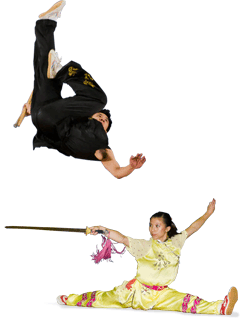 In Chinese, “wushu” translates to martial arts. The origin of wushu can be traced back to the early activities of the ancestors of the Chinese people who struggled hard for survival. During the prolonged cold weaponry age, wushu was employed by the army to subdue the enemy and practiced by the ordinary people as a means for self-defense and physical fitness.
In Chinese, “wushu” translates to martial arts. The origin of wushu can be traced back to the early activities of the ancestors of the Chinese people who struggled hard for survival. During the prolonged cold weaponry age, wushu was employed by the army to subdue the enemy and practiced by the ordinary people as a means for self-defense and physical fitness.
In modern times, wushu has been separated from military warfare and become a sport which includes forms and free-fighting disciplines. Modern wushu forms follow the attack and defense patterns of various traditional Chinese martial arts. They are spectacular to watch, challenging to practice and convey a range of artisitic expressions ranging from playful to fierce.
The Ji Hong Wushu System is divided into five levels. At each level, the practitioner is expected to achieve certain goals which are outlined below.
| Level 1 Requirements | Level 2 Requirements | Level 3 Requirements | Level 4 Requirements | Level 5 Requirements |
|---|---|---|---|---|
| 5 Basic Movements (20%) | Basic Short Weapon (30%) | Compulsory Hand Form (25%) | Optional Hand Form (25%) | Has attended Canadian National Team Selection Competition (30%) |
| 5-Step Form (10%) | Jumping Kicks (20%) | Compulsory Long Weapon Form (25%) | Optional Long Weapon Form (25%) | Has won medals at National Competition of has been selected as a National Team Member (25%) |
| Basic Northern Compulsory Hand Form (30%) | Mini Kick Sections (20%) | Advanced Jumping Kicks (25%) | Difficulty Movements A + B (25%) | Has volunteered as an assistant coach (20%) |
| Flexibility (10%) | ||||
| Kicking Basics (30%) | Basic Long Weapon (30%) | Compulsory Short Weapon Form (25%) | Optional Short Weapon Form (25%) | Able to complete Group A + Group B, or Group C Difficulty (25%) |
| Instructor Level Requirements |
|---|
| Instructor Level A – Has past level 5 requirements |
| Instructor Level B – Has volunteered as an assistant coach |
| Instructor Level C – Led at competitions or demonstrations |
| Instructor Level D – Coached individuals or whole teams |

